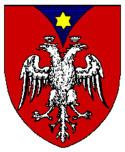Active 1444–50 Strength 8,000 Battles and wars See list | Leaders Skanderbeg Leader Skanderbeg Founded 1444 | |
 | ||
Area of operations Albania VenetaSanjak of AlbaniaSanjak of Dibra Opponents Ottoman Empire, Republic of Venice (Dec. 1447–Oct. 48) | ||
The League of Lezhë (Albanian: Lidhja/Besëlidhja e Lezhës) was a military alliance of feudal lords in Albania forged in Lezhë on 2 March 1444, initiated and organised under Venetian patronage with Skanderbeg as leader of the regional Albanian and Serbian chieftains united against the Ottoman Empire. The main members of the league were the Arianiti, Balšić, Zaharia, Muzaka, Spani, Thopia and Crnojevići. All earlier and many modern historians accepted Marin Barleti's news about this meeting in Lezhë (without giving it equal weight), although no contemporary Venetian document mentions it. Barleti referred to the meeting as the generalis concilium or universum concilium [general or whole council]; the term "League of Lezhë" was coined by subsequent historians.
Contents
Background
After the death of Serbian Emperor Stefan Dušan in 1355, the magnates in Albania established their own dominions. When Ottoman forces entered Albania, they were faced with small principalities that were engaged in vicious fights among themselves. The first battle against the Ottoman forces in Albania was that of Balša II, the Lord of Zeta, who was defeated and killed in the battle of Savra (18 September 1385).
In the 15th century, the Ottoman Empire established itself in the Balkans with no significant resistance offered by local Christian nobles. Many of them were still fighting amongst themselves and didn't see the Ottoman advance as a threat to their power. Although a civil war broke out between Bayezid I's sons in 1402–13, none of the Christian noblemen in the Balkans at the time seized the opportunity to repel the Ottomans; on the contrary, Bulgarians, Serbs and Hungarians even helped the future Sultan Mehmed I seize power, by participating as his allies in the final battle against his brother. After the Ottoman civil war was over in favour of Mehmed I, his forces captured Kruja from the Thopia in 1415, Berat in 1417 from the Muzaka, Vlora and Kanina in 1417 from the widow of Balša III and Gjirokastër in 1418 from the Zenevisi. Under pressure from the Ottoman Empire and the Republic of Venice, the Albanian principalities began to vacillate. Some Albanian nobility revolted in 1432–36.
In November 1443, Skanderbeg captured Kruja with his troops and declared its independence from the Sultan.
Formation
The League of Lezhë was founded on 2 March 1444 by:
The military alliance was made up of the feudal lords in Albania, and was according to Georges Castellan "a precarious alliance". Skanderbeg was elected its leader and commander-in-chief of its combined armed forces numbering 8,000 warriors. All the territorial lords had their own domains and affairs; "Skanderbeg had no right to interfere with the affairs of the domains of other nobles", acting only as the supreme military leader, as primus inter pares.
Through treaties, the league was put under King Alfonso V, with Skanderbeg as captain general.
History
Skanderbeg's forces had victories against the Ottomans at Torvioll (1444), Mokra (1445), Otonetë (1446), Oranik (1448), a loss at Svetigrad (1448), victories at Krujë (1450),
On 4 October 1448, the Albanian–Venetian War ended when Skanderbeg and Nicholas Dukagjini signed a peace treaty with Venice, which would keep its possessions in Albania, including Dagnum, under the conditions that Venice pay a yearly sum of 1,400 ducats, and that some league members would benefit certain trade privileges etc.
Dissolution and aftermath
Though an official date of dissolution is unknown, the League of Lezhë fragmented soon after its founding, with many of its members breaking away. By 1450 it had certainly ceased to function as originally intended, and only the core of the alliance under Scanderbeg and Arianiti continued to fight against the Ottomans. After Peter Spani and George Dushmani left the alliance, and after the Arianiti and Dukagjini left it in 1450, members of Dukagjini family concluded peace with the Ottoman Empire and even began to plot against Skanderbeg.
For 25 years, from 1443–68, Skanderbeg's 10,000 man army marched through Ottoman territory winning against consistently larger and better supplied Ottoman forces. Threatened by Ottoman advances in their homeland, Hungary, and later Naples and Venice – their former enemies – provided the financial backbone and support for Skanderbeg's army. After Skanderbeg's death in 1468, the sultan "easily subdued Albania," but Skanderbeg's death did not end the struggle for independence, and fighting continued until the Ottoman siege of Shkodra in 1478–79, a siege ending when the Republic of Venice ceded Shkodra to the Ottomans in the peace treaty of 1479.
List of battles
The League of Lezhë fought the following battles against the Ottoman Empire and Republic of Venice:
Legacy
The League has been regarded as the first unified Albanian state..
